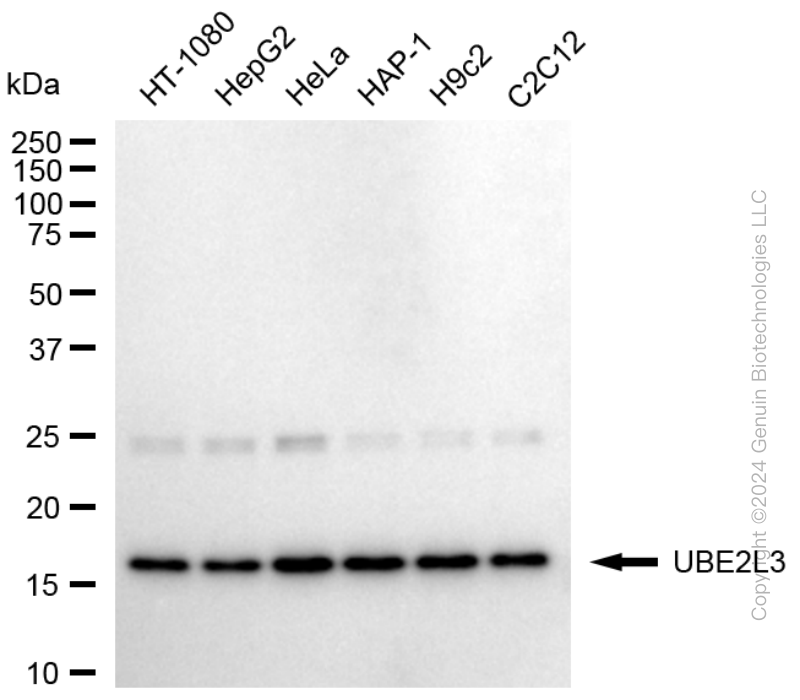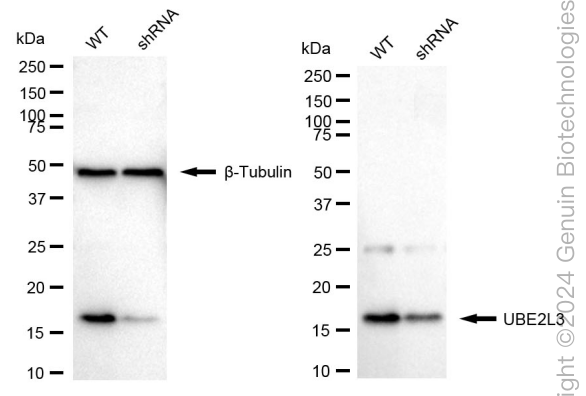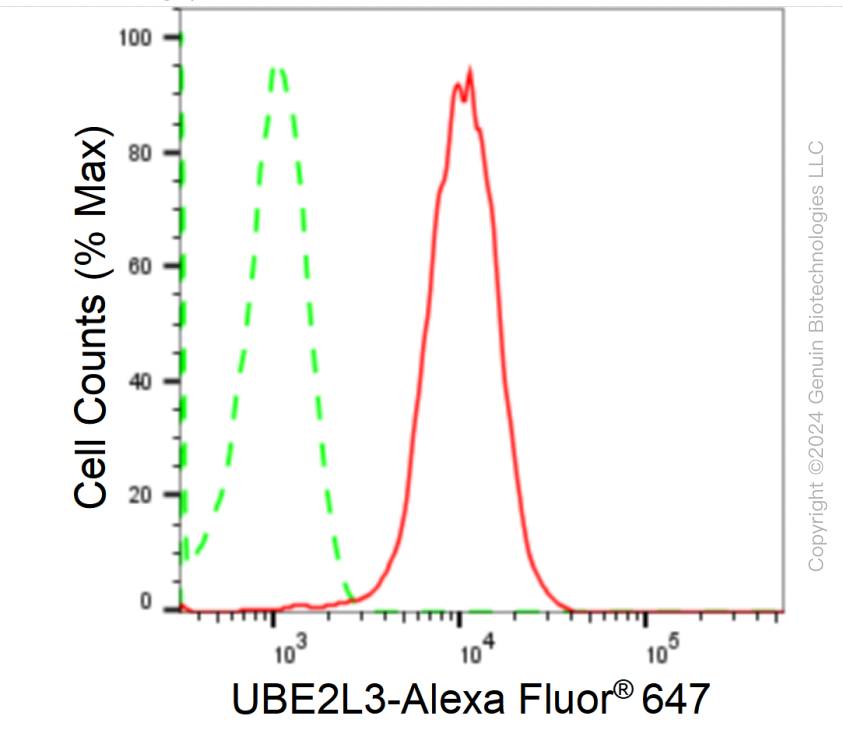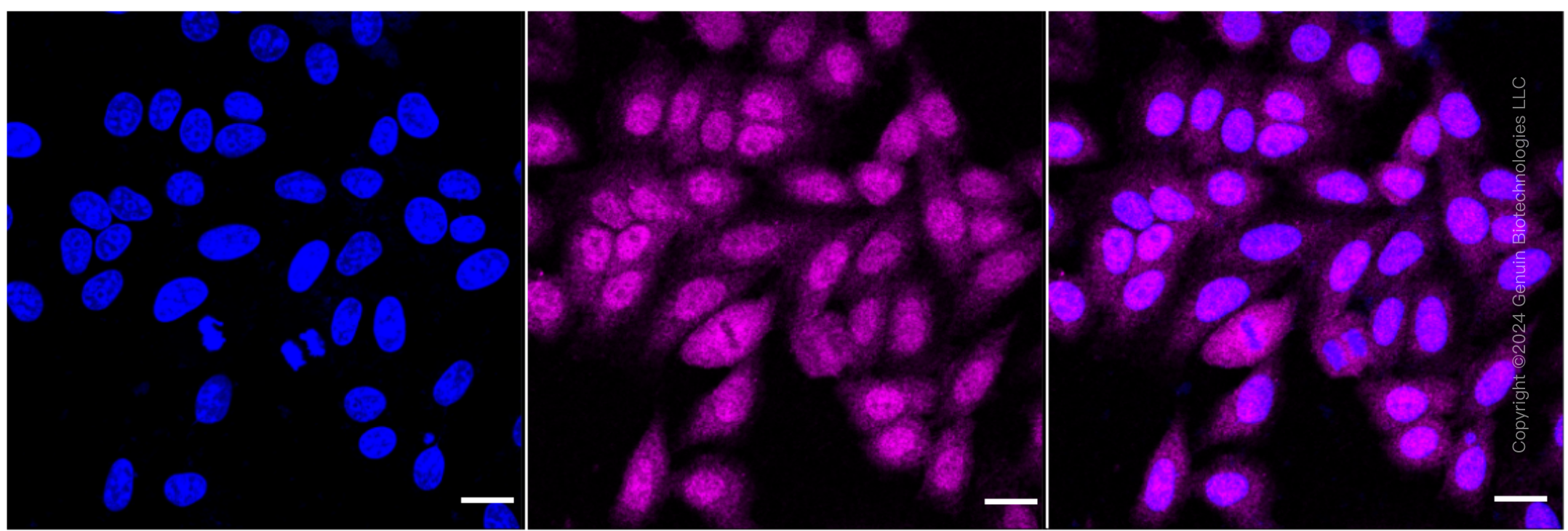KD-Validated Anti-UBE2L3 Rabbit Monoclonal Antibody
Rabbit monoclonal antibody
- SPECIFICATION
- CITATIONS
- PROTOCOLS
- BACKGROUND

Application
| WB, FC, ICC |
|---|---|
| Primary Accession | P68036 |
| Reactivity | Rat, Human, Mouse |
| Clonality | Monoclonal |
| Isotype | Rabbit IgG |
| Clone Names | 24GB1875 |
| Calculated MW | Predicted, 18 kDa , observed , 17 kDa |
| Gene Name | UBE2L3 |
| Aliases | UBE2L3; Ubiquitin Conjugating Enzyme E2 L3; UBCH7; Ubiquitin-Conjugating Enzyme E2 L3; E2 Ubiquitin-Conjugating Enzyme L3; Ubiquitin-Conjugating Enzyme E2-F1; Ubiquitin Carrier Protein L3; Ubiquitin-Protein Ligase L3; L-UBC; Ubiquitin-Conjugating Enzyme E2L 3; Ubiquitin Conjugating Enzyme E2L 3; Ubiquitin-Conjugating Enzyme UBCH7; EC 2.3.2.23; EC 6.3.2.19; E2-F1; UbcM4; UBCE7; UbcH7 |
| Immunogen | A synthesized peptide derived from human UBE2L3 |
| Gene ID | 7332 |
|---|---|
| Other Names | Ubiquitin-conjugating enzyme E2 L3, 2.3.2.23, E2 ubiquitin-conjugating enzyme L3, L-UBC, UbcH7, Ubiquitin carrier protein L3, Ubiquitin-conjugating enzyme E2-F1, Ubiquitin-protein ligase L3, UBE2L3, UBCE7, UBCH7 |
| Name | UBE2L3 |
|---|---|
| Synonyms | UBCE7, UBCH7 |
| Function | Ubiquitin-conjugating enzyme E2 that specifically acts with HECT-type and RBR family E3 ubiquitin-protein ligases. Does not function with most RING-containing E3 ubiquitin-protein ligases because it lacks intrinsic E3-independent reactivity with lysine; in contrast, it has activity with the RBR family E3 enzymes, such as PRKN, RNF31 and ARIH1, that function like RING-HECT hybrids. Accepts ubiquitin from the E1 complex and catalyzes its covalent attachment to other proteins. Mediates ubiquitination by the CUL9-RBX1 complex (PubMed:38605244). In vitro catalyzes 'Lys-11'-linked polyubiquitination. Involved in the selective degradation of short-lived and abnormal proteins. Down- regulated during the S-phase it is involved in progression through the cell cycle. Regulates nuclear hormone receptors transcriptional activity. May play a role in myelopoiesis. |
| Cellular Location | Nucleus. Cytoplasm |
| Tissue Location | Ubiquitous, with highest expression in testis. |

Thousands of laboratories across the world have published research that depended on the performance of antibodies from Abcepta to advance their research. Check out links to articles that cite our products in major peer-reviewed journals, organized by research category.
info@abcepta.com, and receive a free "I Love Antibodies" mug.
Provided below are standard protocols that you may find useful for product applications.
If you have used an Abcepta product and would like to share how it has performed, please click on the "Submit Review" button and provide the requested information. Our staff will examine and post your review and contact you if needed.
If you have any additional inquiries please email technical services at tech@abcepta.com.














 Foundational characteristics of cancer include proliferation, angiogenesis, migration, evasion of apoptosis, and cellular immortality. Find key markers for these cellular processes and antibodies to detect them.
Foundational characteristics of cancer include proliferation, angiogenesis, migration, evasion of apoptosis, and cellular immortality. Find key markers for these cellular processes and antibodies to detect them. The SUMOplot™ Analysis Program predicts and scores sumoylation sites in your protein. SUMOylation is a post-translational modification involved in various cellular processes, such as nuclear-cytosolic transport, transcriptional regulation, apoptosis, protein stability, response to stress, and progression through the cell cycle.
The SUMOplot™ Analysis Program predicts and scores sumoylation sites in your protein. SUMOylation is a post-translational modification involved in various cellular processes, such as nuclear-cytosolic transport, transcriptional regulation, apoptosis, protein stability, response to stress, and progression through the cell cycle. The Autophagy Receptor Motif Plotter predicts and scores autophagy receptor binding sites in your protein. Identifying proteins connected to this pathway is critical to understanding the role of autophagy in physiological as well as pathological processes such as development, differentiation, neurodegenerative diseases, stress, infection, and cancer.
The Autophagy Receptor Motif Plotter predicts and scores autophagy receptor binding sites in your protein. Identifying proteins connected to this pathway is critical to understanding the role of autophagy in physiological as well as pathological processes such as development, differentiation, neurodegenerative diseases, stress, infection, and cancer.





